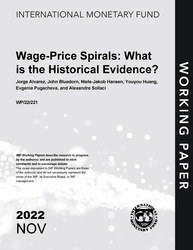
Wage-Price Spirals: What is the Historical Evidence?
Wage-Price Spirals: What is the Historical Evidence?
READ MORE...
Volume/Issue:
Volume 2022
Issue 221
Publication date: November 2022
ISBN: 9798400224294
$20.00
Add to Cart by clicking price of the language and format you'd like to purchase
Available Languages and Formats
| English |
Prices in red indicate formats that are not yet available but are forthcoming.
Topics covered in this book
This title contains information about the following subjects.
Click on a subject if you would like to see other titles with the same subjects.
Inflation , Labor , Economics- Macroeconomics , Economics / General , Inflation , Wages , Wage-price spirals , Labor markets , , wage-price spiral , nominal wage growth , Phillips curve , Phillips Curve estimation , Wage-Price spiral , Real wages , Labor markets , Wage adjustments
Also of interest
Summary
How often have wage-price spirals occurred, and what has happened in their aftermath? We investigate this by creating a database of past wage-price spirals among a wide set of advanced economies going back to the 1960s. We define a wage-price spiral as an episode where at least three out of four consecutive quarters saw accelerating consumer prices and rising nominal wages. Perhaps surprisingly, only a small minority of such episodes were followed by sustained acceleration in wages and prices. Instead, inflation and nominal wage growth tended to stabilize, leaving real wage growth broadly unchanged. A decomposition of wage dynamics using a wage Phillips curve suggests that nominal wage growth normally stabilizes at levels that are consistent with observed inflation and labor market tightness. When focusing on episodes that mimic the recent pattern of falling real wages and tightening labor markets, declining inflation and nominal wage growth increases tended to follow – thus allowing real wages to catch up. We conclude that an acceleration of nominal wages should not necessarily be seen as a sign that a wage-price spiral is taking hold.
Copyright © 2010 - 2026
Powered by:
AIDC



